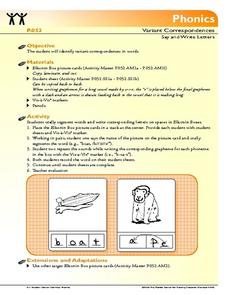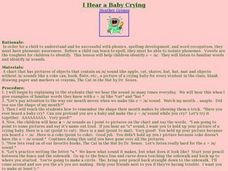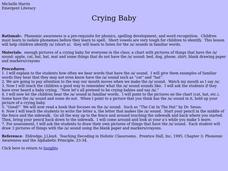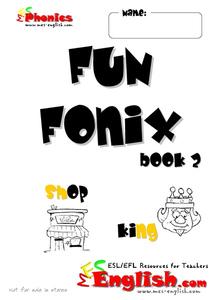Florida Center for Reading Research
Phonics: Variant Correspondences, Say and Write Letters
Scholars sound out and write twelve different words. Using Elkonin boxes, pupils say the name of each picture, then write the letters that make each sound.
Curated OER
Blending Syllables Name Game
What a fun way to practice segmenting words into syllables! Engage learners by using their own names, spoken by Mico the puppet (or one of your favorites). Mico announces names slowly, syllable by syllable. If scholars have a...
Curated OER
Phonics: Read and Write Words with a Consonant Blend
Reading often times starts with phonemic awareness and letter sound correspondence. Get little ones blending those letter sounds together to read and write simple words. As the teacher sounds out each word, learners count phonemes, and...
Florida Center for Reading Research
Picture Slide
Here is another fun and engaging way to help youngsters build phonological awareness. In pairs, they use the provided picture cards to sound out segments of words. As they slide the picture together they say a segment of the...
Florida Center for Reading Research
Phonics: Onset and Rime, Change-A-Word
Kids use their phonological know-how to identify and segment onset and rime blends. Double rime picture cards (cat and hat) are chosen, then matched to onset cards that make each word, such as the k sound for a cat and the h sound for a...
Curated OER
Making More Words With "at"
Young scholars explore phonetics by identifying words with one specific sound. In this rhyming words lesson, students discuss the sound "at" and the many words that contain the same sound. Young scholars utilize index cards to...
Curated OER
Grandpa Ed
Students engage in an emergent literacy lesson plan that focuses on phonemic awareness. For practice they become more comfortable with a short vowel phoneme, which can often be the most difficult to identify, by learning it in isolation.
Curated OER
Don't Wake Mama
Students identify the digraph /sh/ in written and spoken language. After a brief discussion of the independent and combined sounds of the phonemes /s/ and /h/ students practice identifying initial and final placement of the new digraph...
Curated OER
I Hear a Baby Crying
Students recognize the short vowel a in written and spoken language. Through matching activities, they discriminate the short vowel /a/ from other phonemes. Students associate the phoneme with its letter representation and identify the...
Curated OER
Crying Baby
Pupils explore phonemes. They discuss the short a sound. Students discuss the shape their mouths make when saying /a/. They read familiar words with the /a/. Pupils read "The Cat In The Hat." They identify words with the short a sound.
Curated OER
Phonemic Segmentation
Students shown how to hear and manipulate the sound in words. They isolate the first sound in a word, the last sound in a word, and all the sounds in a word. Students are told that they are going to hear words and they need to take...
Curated OER
Beginning and Ending Sounds
First graders practice their letter and word recognition skills. In this initial and final sounds lesson, 1st graders participate in a classroom activity that requires them to blend phonemes into spoken words and sound out multisyllable...
Curated OER
Teaching Pronunciation
Using repetition, students communicate with the instructor by isolating the phrase or words to promote better pronunciation.
Curated OER
Identify Base Words and Suffixes to Read Multisyllabic Words #1
Show your scholars how adding an affix changes the entire meaning of a word; they focus on the suffix -able. You'll find a complete script here, but if you don't want to read this verbatim, use it simply as an outline. Learners watch you...
Alabama Learning Exchange
Phonics lesson for -ick family
Kindergarteners and first graders develop phonemic awareness for words that contain -ick. Each learner gets a stack of cards with different -ick words, highlighting the target sound as they review each one.
University of Florida
Phonological Awareness: A Sound Beginning
Choose from a variety of phonological activities to complement a reading lesson. The guide goes through the basic components of good phonics instruction focusing on sound types, levels of phonological awareness, assessment methods, and...
Florida Center for Reading Research
Phonological Awareness
Kindergarteners and first graders alike are engaged as they learn the initial sounds of objects by taking turns flipping cards to form a long train. This complete and ready-to-print activity helps young ones build the basic foundations...
Literacy Connects
Activities to Build Phonological Awareness
Begin your reading program each day with a mini lesson on phonological awareness using these engaging activities listed in the resource. Young ones will enjoy word families, clapping and counting syllables, identifying single sounds and...
Houghton Mifflin Harcourt
A World of Animals: Extra Support Lessons (Theme 10)
Provide extra support with this collection of animal-themed lessons. Early readers gain proficiency in high frequency words are and he, practice blending short vowel sounds, and substitute initial and final phonemes while creating...
Briarwood Presbyterian Church
Phonics Lesson Planning Guide
So much to teach, so little time. Keep track of phonics instruction with a guide that permits you to plan phonics lessons addressing 12 difference concepts, in four strands, in the handwriting, maintenance, instruction, and extension...
Pennsylvania Department of Education
What's My Sound?
Learners follow a power point presentation to practice the sounds each letter of the alphabet make. In this 'what's my sound' lesson, students apply word recognition strategies and demonstrate listening and comprehension skills to build...
Curated OER
Putt-Putt Old Car
Students study the phoneme /p/ both in written and spoken language while differentiating from the phoneme /b/. They think about the "put, put" sound that an old car makes, and work with at tongue twister. Next, they write the letter p,...
Jumpstarting Journeys
Vowel Digraph Activities for au and aw
It can be awfully hard teaching young children how to read, but this phonics resource will make the job a little easier. Focusing on the au and aw vowel digraphs, this collection of engaging activities teaches beginning readers how to...
Fun Fonix.com
Fun Fonix
Who says you can't have fun while learning to read? This collection of matching, tracing, and spelling worksheets engages beginning readers as they develop an understanding of consonant digraphs.
Other popular searches
- Phoneme Isolation Activities
- Phoneme Isolation S
- Phoneme Isolation K
- Phoneme Isolation Y
- Phoneme Isolation Lessons

























